He lied to her. He came all the way across a thousand galaxies, just to lie to her.
He gave her a false name. He insinuated his way into her life. He became a co-worker, a friend. She trusted him. She confided in him. He was the person that knew her better than anyone else, the man who could see right through her.
And he lied to her.
They traveled together. They solved mysteries together. They survived a thousand hair-raising adventures together, one life-threatening, heart-stopping moment after another.
He used his super-ventriloquism, to make her think that he was in two places at once. He used his heat vision, to destroy the telltale evidence that would have confirmed her suspicions. He created dreams and hoaxes and imaginary stories, to confuse and distract her. He even invented a fucking robot duplicate of himself, specifically in order to keep his secret from specifically her. She trusted him, and he lied to her, and he did it for decades. And he thought it was funny.
So now, you want to ask why Lois Lane is so stupid that she never recognized the truth that Superman did everything possible to conceal from her?

We’ve arrived at a tricky moment in Superman: The Movie — the end of Act 2, when the film stops being a romantic comedy, and becomes an action-adventure story. For the last 46 minutes, since Clark’s arrival in Metropolis, the movie has mostly been concerned with the Clark/Lois/Superman love triangle. Sure, there have been periodic intrusions by Luthor and his gang, but they’ve been kept discreetly away from the main storyline — an undercurrent, rather than a subplot.
Superman and Lois are just wrapping up the interview/love scene/musical number, a twelve-minute long sequence where the world stops turning, and nothing matters besides watching these two kids fall in love — and once it’s over, Superman and Lois don’t appear in a scene together for another 35 minutes. It’s the movie’s big structural flaw, that it spends so much time building Lois up, and then leaves her out in the desert somewhere while the plot points happen to other people.
This is our next-to-last chance to see Superman and Lois together, and it ends with something special — the man transforming from Clark into Superman and back again, before our eyes.

And it’s wonderful, a clever one-take special-effects sequence that’s accomplished entirely through glasses, tone of voice and posture. Clark straightens up, squares his shoulders, and calls out to Lois in a clear, strong voice that he has something important to tell her — and then he loses his nerve, and shrinks back into the guise and garb of Clark Kent, all sloping shoulders and nervous mannerisms.
People get a little over-excited about this scene — it’s acting, it’s not like Christopher Reeve invented the idea of playing different characters — but it’s a nice moment that lends some credence to the premise that Lois might not recognize that she’s about to go to dinner with the same guy that just flew off her balcony sixty seconds ago.
But that question — why doesn’t she recognize him? — is another one of those stupid questions, like “Where does his cape go when he’s dressed up like Clark Kent?”, which is a part of the premise that you just need to accept in order to enjoy having stories about Superman in your life.

The fact is that Siegel and Shuster set up this ludicrous premise with no interest whatever in whether it made logical sense or not. They were producing a silly adventure comic about an extraterrestrial roughneck who laughed at bullets and pulled planes out of the sky. Verisimilitude was not an issue.
America fell in love with this man and this woman almost instantly, before we even knew what we were falling in love with. The audience didn’t expect superhero comics to make logical and emotional sense, because before this, there were no superhero comics to have any expectations about. Lois hated Clark and loved Superman as of page ten of Action Comics #1; it was an established fact before anybody even had time to wonder about it.
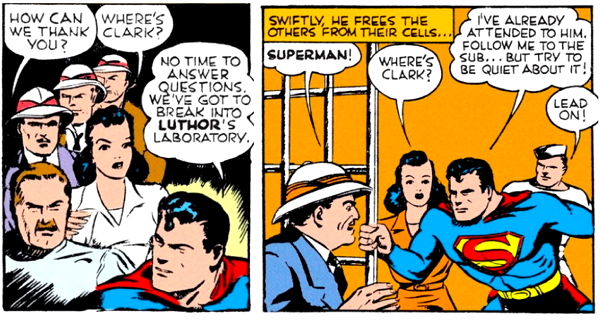
To the extent that anyone cared in the first few years, the double-identity problems were handled using the Where’s Clark gambit, as seen in the above two panels, both from the same story in Superman #12.
The Where’s Clark gambit relies on the pace of the story being so frenetic that any skepticism is left in the gutters between panels. Lois asks “Where’s Clark?” and Superman answers, “No time to answer questions!” or “I’ve already attended to him!” And then in the next panel, he smashes his way through a door and starts breaking furniture, like he always does. Nobody has time to wonder why Lois doesn’t recognize Clark, because Superman is punching people, and then the story’s over.
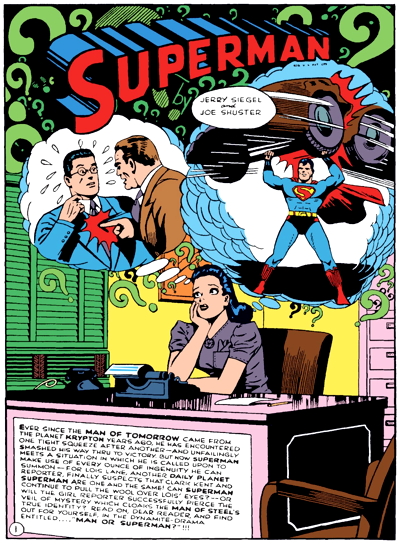
By 1942, they realized that Lois almost seeing through Clark’s disguise was a story-productive idea, and they made a huge deal about it in Superman #17, in a story called “Man or Superman?”
In this story, Clark gets careless, and phones in a story about an accident in the subway that Lois knows he couldn’t possibly have known, unless he was Superman. The next day, she decides, “I’m going to find out once and for all if Clark is Superman or not!” and then proceeds to plunge herself and Clark into a dangerous situation.

She basically barges right into a supervillain’s hideout and dares him to do something about it, and he does, putting the two reporters into a crazy, over-complicated contraption involving a glass cage and a death pendulum. The only way out is for Clark to turn into Superman without Lois noticing, which he accomplishes using super-speed to make a temporary Clark Kent dummy out of a bunch of nearby rags.
The trick ultimately requires Lois to believe that Superman suddenly appeared in the room, saved her, and then suddenly vanished, except the door is still locked and the room doesn’t have any windows. In other words, this is exactly the proof that she’s looking for, because the only explanation for what happened is that Clark is Superman. But she doesn’t see that somehow, and that’s how this is going to go, for the next several decades.
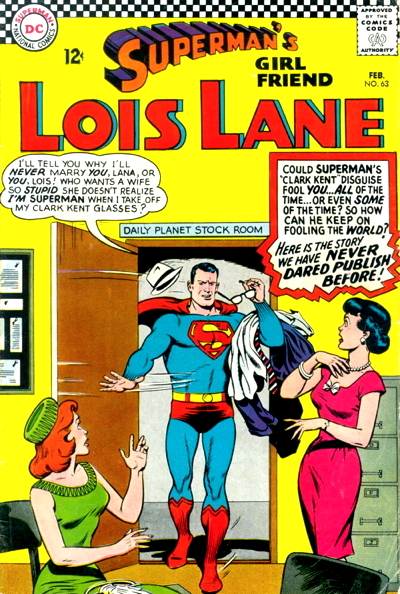
Naturally, you can’t pull stunts like that for more than a decade or two before people start thinking that it’s odd. By the time they reached the Silver Age in the late 1950s to mid 60s, the Superman crew were regularly publishing shock-covers that promised startling changes to the status quo.
This is my favorite example, from March 1966’s Superman’s Girl Friend Lois Lane #63. On the cover, Superman storms out of the stock room to startle Lois and Lana, tearing off his glasses and shouting, “I’ll tell you why I’ll never marry you, Lana, or you, Lois! Who wants a wife so stupid she doesn’t realize I’m Superman when I take off my Clark Kent glasses?”
“Could Superman’s ‘Clark Kent’ disguise fool you…” the cover blurb challenges, “all of the time… or even some of the time? So how can he keep on fooling the world? Here is the story we have NEVER DARED PUBLISH BEFORE!”
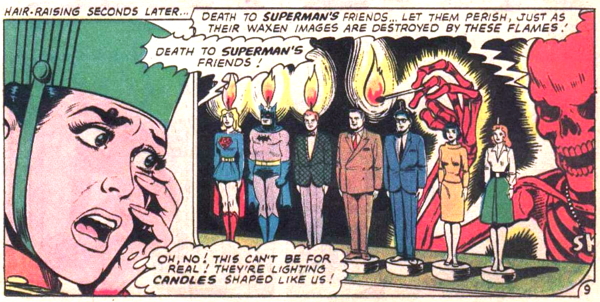
Naturally, the story inside does not deliver on that promise in even the tiniest way. It’s a thoroughly wackadoodle tale about an evil anti-Superman cult where everybody dresses up like glowing skeletons, and make detailed wax figurines of Superman’s friends, just like every Silver Age story ever written, except more confusing.

To justify the cover, there’s a panel where Superman bursts out of the stock room and reveals his identity, which goes nowhere.
“It’s typical of your hair-brained schemes!” Superman shouts, chastising Lois and Lana for stuff that isn’t their fault. “You just don’t think — which is why I’ll never marry either of you! Who wants a wife so dumb she doesn’t realize I’m Superman when I take off my Clark Kent glasses?”
“Nonsense!” Lana protests. “You know we’ve often suspected you’re really Clark!”
“Only because of the physical resemblance,” he retorts. “But appearances can be deceiving! You see, Kent isn’t Superman… and neither am I!”
And then he whisks off both his glasses and his mask, and it’s actually Van Benson, who’s filling in temporarily as the editor of the Daily Planet because Perry White has been temporarily appointed to the U.S. Senate.
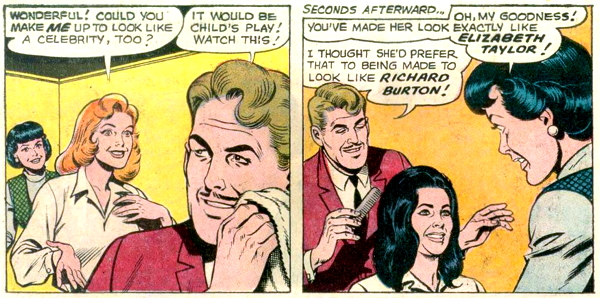
Benson reveals that he’s not actually a newspaper editor — he’s a master of disguise, who’s currently working for the FBI in order to infiltrate the anti-Superman skeleton cult. Everyone is so delighted by his Superman practical joke that he spends the next couple pages showing off his disguise skills, making Lana look like Elizabeth Taylor in a matter of seconds.
The whole thing is so screwy that everybody stops paying attention to the fact that Benson was just saying that Superman and Clark are obviously the same person. The answer “No time to answer questions!” actually looks pretty reasonable, compared to this.
But in 1978 — with an exciting live-action Superman movie about to hit the screens — the Superman comics finally decided to come up with a stupid answer to this stupid question, revealing to the public how he actually tricks people into not recognizing him as Clark Kent. But that’s a whole other story, and I’ve got a new superhero movie to go and see.
So I’m going to leave you in suspense for the weekend, while I write about Spider-Man: No Way Home, and I’ll come back on Monday to tell you all about the brilliant and entirely unsatisfying solution to this decades-old problem.
This weekend:
A special post about Spider-Man: No Way Home!
93.1: The Big Deal

— Danny Horn

He thought it was funny?
I never thought that. That would just make him a jerk.
Superman may not even realize himself why it matters so much that Lois not find out his secret identity. Obviously, the fewer people who know, the safer it is for his mom. If villains knew Superman was Clark Kent, Ma might be a target. Maybe he worried that the same thing might happen if Superman dated Lois. No one would care if Lois dated Clark. (Well, maybe The Daily Planet HR Department.) He had lost so many people in his young life–his whole family and his adopted father. He wouldn’t want to put Lois at greater risk than she regularly put herself. Plus, Lois inadvertently reveals his inability to see through lead to the world, so maybe he has a point in not telling her who he is.
But maybe there was more to it. He wanted to be loved as a man, not a god. He wanted love, not worship. He wanted Lois to look beyond Superman. The fact that she can’t see that Clark is Superman shows she’s not ready. Clark was a test to see if he could be loved as a deliberately ordinary guy. The fact that he makes Clark SO undesirable may show that he’s not ready yet, either.
Omg, I’m talking about Superman and Lois as if they have deep character motivations!
Hidden identities are a large part of “My Man Godfrey”, “Tovarich” and “Sullivan’s Travels”, all screwball comedies. This is the end of that phase of the movie, unfortunately.
But Spiderman! Cool.
LikeLiked by 2 people
Is this stupid answer SPELLBINDING?
LikeLiked by 1 person
Oops. Spider-Man, not Spiderman. I read the newspaper comic as a kid and I never realized it was spelled with a hyphen. I guess Lois isn’t the only one who’s unobservant and can’t spell.
LikeLiked by 2 people
If memory serves, the hyphen was added to make his name look different from Superman.
LikeLiked by 1 person
I always forget that it’s not Spiderman as well. I blame Superman for that.
LikeLike
This is a problem in any serial narrative. In a regular story, you build tension, resolve it, The End. In a comic, you have to find a new, better source of tension.
With “Superman,” though, there isn’t much of anywhere to go. A secret identity is an endless source of drama. The basic issue of identity is a gold mine; Shakespeare had plenty of imposters and masks and crossed wires.
They finally let Clark and Lois marry, which ruined everything. They let Spider-Man marry, and it was such a bad idea, they had the devil rewrite history to unmarry him.
LikeLiked by 2 people
Yes, will they-won’t they is much more of a hook. I noticed as a kid that when the characters got married on tv shows, it meant the end of the series was near (“I Dream of Jeannie” and “Get Smart” for examples.)
LikeLiked by 2 people
The second characters get together it’s a death knell. The only way it works if if they’re married or an established couple from the get go.
Even Superman: The Movie, couldn’t resolve the whole “Lois can’t see what’s right in front of her” and had to leave her out of the climax of the film!
LikeLiked by 1 person
“…I’ll come back on Monday to tell you all about the brilliant and entirely unsatisfying solution to this decades-old problem.”
It’s that stupid story about the glasses, isn’t it? I think Elliot Maggin wrote that one and it was bad even by his abysmal standards.
LikeLiked by 1 person
It is the stupid story about the glasses.
LikeLiked by 1 person
Oh crap! The stupid story about his glasses!
At least the villain is interesting…
LikeLike
With respect to Maggin, it was Martin Pasko who wrote the glasses story.
And yes, it is hella stupid.
LikeLiked by 1 person
I think the comic book panels you’ve included in the post show why this stupid question is of a different order than the stupid question about what Supey does with his Clark Kent clothes when he’s in his outfit.
The key to a successful Superman comic is constant movement. Each still image has to suggest a whole package of motions leading up to it and away from it. The question, “What does The Flash do with his secret identity clothes when he’s in costume?” opened the way to some interesting visuals, because his stories are all about time-slice imagery, where we freeze on a single instant within an extremely rapid process. But in a Superman story everything is moving all the time, and the readers are filling in the steps for any number of processes in every panel, so “Changing Clothes” is a story you tell with one detail in a panel where several other stories, all of them more interesting, are also being told.
Lois trying to figure out whether Superman and Clark Kent are different people is an interesting story. A comic book centering on it is successful if it’s made up of images like those of Van Benson above. An investigator who stopped for a moment and thought about the question would immediately be overwhelmed by the evidence that Supey and Clark are one and the same. But people who stop for a moment have no place in a Superman comic. Everything is always happening all at once. So, while a “Where does Superman keep his Clark Kent clothes when he’s in costume?” story is a guaranteed dead duck, a “Lois investigates Superman’s secret identity” story builds in a test for its own worthiness.
LikeLiked by 1 person
I’ve got several comments about this one. 🙂 First I’m kind of disappointed that you didn’t tie it in to the fictional trope of identical cousins. I watched a lot of 1960s, 1970s TV as a kid thanks to strip syndication and it was clearly an established thing that there can be 2 people who aren’t twins that are basically identical. That was the entire premise of The Patty Duke Show. Both Bewitched and I Dream of Jeanie had characters that were the star in a black wig. It was just an accepted thing. If Clark and Superman just happened to look pretty identical it didn’t mean they were the same person. 🙂 Second, just sort of a tangent, but the show Laredo had an episode where a main character had someone come on who looked different, but sounded exactly like him. It was pretty clever and I’ve never seen another show copy it. Third, it’s worth mentioning the best secret identity of all time – Mr. Snuffleupagus on Sesame Street. When I was little no one else on the street had ever seen Snuffy except Big Bird. They thought Snuffy was Big Bird’s imaginary friend. SO MANY NEAR MISSES and I so wanted someone else to see him and then they did. And it was so boring. I was totally wrong. They had a good reason though they didn’t want children to think that people wouldn’t believe them if they told them about abuse which was good societally and bad storywise.
LikeLiked by 1 person
The reason why Clark starts to reveal his identity and then backs out is explained very well by the deleted scene with Jor-El, as I mentioned in my lengthy comment under entry 1.65. Without the warning from his father that public knowledge of his identity would endanger the ones he loves, Superman would have gone through with it. In fact he’s quite eager to tell her the truth. Telling a lie is not in his nature so it’s hard to keep the secret; it’s practically bursting out of him in this scene.
Unfortunately, without the deleted Jor-El scene, the audience is left wondering why Superman changed his mind. Maybe he just chickened out because he’s afraid of her reaction? Superman’s change back into timid Clark loses its meaning and impact when we don’t understand what’s behind his indecision.
LikeLike
Except, if it were for Siegel and Shuster the K-Metal from Krypton would be released in 1942 and no Clark – Lois – Superman triangle would plague comics for over 50 years
Also Siegel and Shuster bothered enough to explain why he is very strong and very agile (because lower gravity and Kryptonians are just more advanced ,biologically, humanoids). They bothered to explain why his suit never tearing (because it is made from special chemical that Superman invented himself)
Also Superman doesn’t have any relatives, Kents are dead. Both of them, this isn’t The Movie. And Lois got kidnapped by thugs anyways.
LikeLike